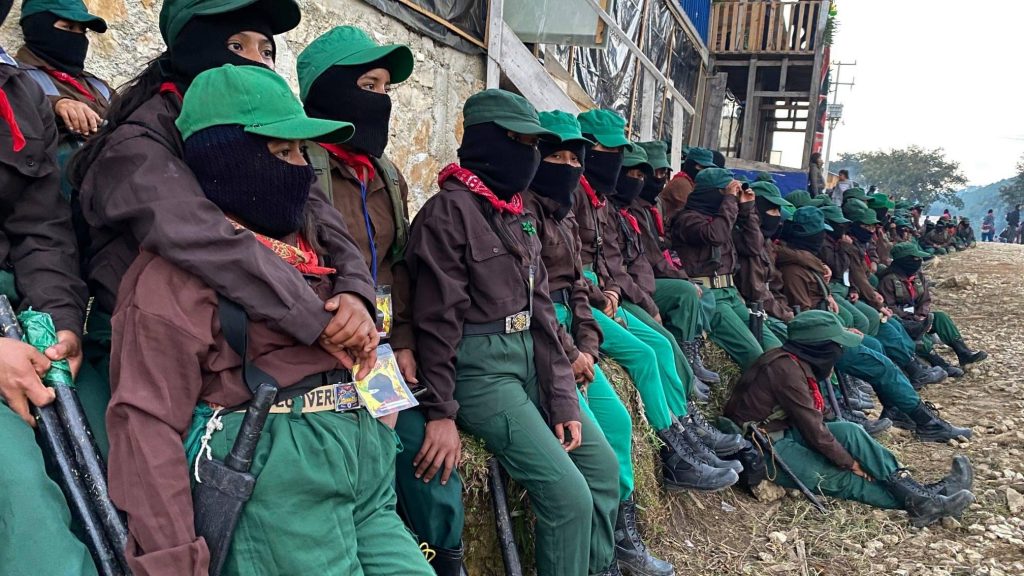
By Raúl Zibechi
In these vicious times there is little to celebrate. With the darkness of the system becomes routine, when those from above rob us with death and violence, the lights from below shine with all of their resplendence, rending the night, illuminating the trails and the slopes. The 37th anniversary of the Zapatista Army of National Liberation is, certainly, the most powerful light in the Latinamerican firmament.
The EZLN celebrates its 37th anniversary facing one of the largest military offensives in a long time, encouraged by the progressive government of Andrés Manuel López Obrador, by the governments of Chiapas and of various municipalities of the state, who launched a war of attrition against the autonomous territories, to deprive and destroy the EZLN and its bases of support.
But, what are we celebrating specifically? The continuity and perseverance of a revolutionary movement distinct from everything that came before, something that we should value in all of its transcendence. Not only did they not give up, not sell out, and not betray but they did not repeat the vanguardist scheme that reproduces the dominant culture in converting its leaders into new elites.
We celebrate the coherence, but also all that they have taught us in these almost four decades. To not speak generally, I want to refer to what I have learned, whether it be in the Escuelita Zapatista[1] or in many other encounters and exchanges in which I was able to participate.
The core of Zapatismo is autonomy. Not theoretical or declarative, but in living practice of the people in each and every one of the moments and spaces where they make their lives, from the ejidos and the communities, to the municipality and the councils of good government. Autonomy is a way of life, it is the dignity of the pueblos; collective autonomy, not individual like some eurocentric thinking has conveyed.
We need autonomy to continue being people and social sectors that practice ways other than that from those above. Autonomy can be practiced in all of its spaces, in the neighborhoods of the cities, between peasant farmers, indigenous and black people, in the most diverse collectives and communities.
Autonomy is this immense umbrella of dignity that we sustain between all of us. It is not an institution, it is living human relationships, woven with the dignity that allows us to be brothers and sisters.
The bases of support and the EZLN taught us also that autonomy should be complete, integral, or at least tending toward that, encompassing all of the aspects of the peoples’ lives. This is why they build schools, clinics, hospitals, cooperatives, and all the rich framework of production of life and care of life. Autonomy is combined with self-governance and with autonomous justice; the collective works are the engine of autonomy.
Defense of territories and communities is another of the teachings of the EZLN. But here another feature of autonomy appears, unprecedented in the field of the revolution; the defense of our spaces cannot be a mere reaction to what those above do to us. To choose how, when and in what way we act is also a feature of autonomy, so as to not fall into provocation, because they want war, because war always benefits capital.
To this point, the EZLN has shown us to not respond to aggression with aggression, death with death, war with war, because at that point, we stop being autonomous, that is, we stop being different. And this has nothing to do with pacifism.
We learned that there is no single mode of autonomy that is valid for all people at all times. They have shown us that each walks in her own way and according to her time, and this is what the peoples of Latin America are doing.
I can testify to the way that the autonomies are expanding across our continent. Scores of Mapuche communities in the south of Chile and Argentina are rebuilding themselves in an autonomous way, confronting the policies of states that present them as terrorists.
The Regional Indigenous Council of Cauca, in the south of Colombia, is a remarkable expression of building autonomy. The indigenous guard is expanding into black and peasant villages which have been protagonists in the recent Indigenous, Black and Peasant Minga that ended in Bógota after a 500 kilometer walk. (https://bit.ly/2IMRFQk)
In Perú the Autonomous Territorial Government of the Nation of Wampis has been formed, a process that three other Amazon peoples of the north are following. In the Brazilian Amazon 14 peoples are moving toward autonomy to defend themselves from the mining and agribusiness, as the militant geographer Fábio Alkmin has shown in his ongoing research.
It would be unfair to give the impression that all of the autonomies are following the same path as the EZLN. But I want to emphasize that the existence of the EZLN is an impulse, a reference point, a light that tells us that it is possible to resist capital and capitalism and that it is possible to construct other worlds, resisting and living with dignity.
This piece was originally published in Spanish in La Jornada on November 20th, 2020. https://www.jornada.com.mx/2020/11/20/opinion/024a1pol English interpretation has been published by Chiapas Support Network and Schools for Chiapas.
